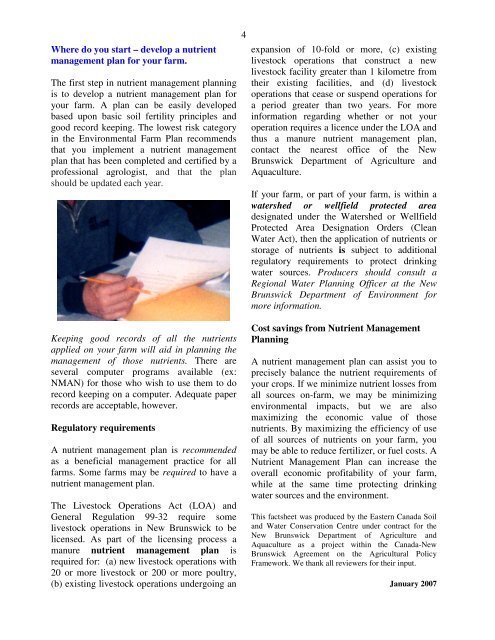You also want an ePaper? Increase the reach of your titles
YUMPU automatically turns print PDFs into web optimized ePapers that Google loves.
Where do you start – develop a nutrient<br />
management plan for your farm.<br />
The first step in nutrient management planning<br />
is to develop a nutrient management plan for<br />
your farm. A plan can be easily developed<br />
based upon basic soil fertility principles and<br />
good record keeping. The lowest risk category<br />
in the Environmental Farm Plan recommends<br />
that you implement a nutrient management<br />
plan that has been completed and certified by a<br />
professional agrologist, and that the plan<br />
should be updated each year.<br />
4<br />
expansion of 10-fold or more, (c) existing<br />
livestock operations that construct a new<br />
livestock facility greater than 1 kilometre from<br />
their existing facilities, and (d) livestock<br />
operations that cease or suspend operations for<br />
a period greater than two years. For more<br />
information regarding whether or not your<br />
operation requires a licence under the LOA and<br />
thus a manure nutrient management plan,<br />
contact the nearest office of the New<br />
Brunswick Department of Agriculture and<br />
Aquaculture.<br />
If your farm, or part of your farm, is within a<br />
watershed or wellfield protected area<br />
designated under the Watershed or Wellfield<br />
Protected Area Designation Orders (Clean<br />
Water Act), then the application of nutrients or<br />
storage of nutrients is subject to additional<br />
regulatory requirements to protect drinking<br />
water sources. Producers should consult a<br />
Regional Water <strong>Planning</strong> Officer at the New<br />
Brunswick Department of Environment for<br />
more information.<br />
Keeping good records of all the nutrients<br />
applied on your farm will aid in planning the<br />
management of those nutrients. There are<br />
several computer programs available (ex:<br />
NMAN) for those who wish to use them to do<br />
record keeping on a computer. Adequate paper<br />
records are acceptable, however.<br />
Regulatory requirements<br />
A nutrient management plan is recommended<br />
as a beneficial management practice for all<br />
farms. Some farms may be required to have a<br />
nutrient management plan.<br />
The Livestock Operations Act (LOA) and<br />
General Regulation 99-32 require some<br />
livestock operations in New Brunswick to be<br />
licensed. As part of the licensing process a<br />
manure nutrient management plan is<br />
required for: (a) new livestock operations with<br />
20 or more livestock or 200 or more poultry,<br />
(b) existing livestock operations undergoing an<br />
Cost savings from <strong>Nutrient</strong> <strong>Management</strong><br />
<strong>Planning</strong><br />
A nutrient management plan can assist you to<br />
precisely balance the nutrient requirements of<br />
your crops. If we minimize nutrient losses from<br />
all sources on-farm, we may be minimizing<br />
environmental impacts, but we are also<br />
maximizing the economic value of those<br />
nutrients. By maximizing the efficiency of use<br />
of all sources of nutrients on your farm, you<br />
may be able to reduce fertilizer, or fuel costs. A<br />
<strong>Nutrient</strong> <strong>Management</strong> Plan can increase the<br />
overall economic profitability of your farm,<br />
while at the same time protecting drinking<br />
water sources and the environment.<br />
This factsheet was produced by the Eastern Canada Soil<br />
and Water Conservation Centre under contract for the<br />
New Brunswick Department of Agriculture and<br />
Aquaculture as a project within the Canada-New<br />
Brunswick Agreement on the Agricultural Policy<br />
Framework. We thank all reviewers for their input.<br />
January 2007
















